In this article, I will review 14 best lenses for real estate photography for Canon and Nikon Cameras in 2020.
In addition, I will provide an actionable Buyers Guide on choosing the best lenses for real estate photography based on your budget and specific needs, irrespective of your camera brand.
Editors' Picks
Best Budget Canon Lens
Canon EF 17-40 mm f/4L USM Lens
This ultra wide-angle zoom lens is compatible with both full-frame Canon EF-mount DSLRs and APS-C models.
With APS-C models, the equivalent focal length is 27.2-64 mm.
Note that it has no image stabilization system, So, perhaps using it on a tripod is better for achieving a great image sharpness.
Best Budget Nikon Lens
Nikon AF-S NIKKOR 50 mm f/1.8G Lens
A great compact prime lens for real estate photography!
It is designed for FX-format Nikon F-mount DSLR cameras.
However, it is also compatible with DX-format cameras and provides an equivalent 75 mm focal length.
Just note that it does not have any image stabilization system to reduce the effects of shake.
So, it is better to use it with a tripod or monopod.
Best Canon Lens
Canon EF 14 mm f/2.8L II USM Lens
This is one of the best prime lenses for real estate photography due to its wide angle.
It is designed for full-frame Canon EF-mount DSLR cameras and works fine with APS-C models as well.
Best Nikon Lens
Nikon AF-S FX NIKKOR 20 mm f/1.8G ED Lens
If you are looking for a professional prime lens for real estate photography, then you should go for this NIKKOR 20mm ED lens.
It is designed for the FX-format Nikon F-mount DSLR cameras.
It can also be used with the DX-format cameras. In this case, the equivalent focal length will be 30 mm.
Best Canon Real Estate Lens
Canon EF-M 32 mm f/1.4 STM Lens
One of the most recently introduced mirrorless lenses that is also ideal for real estate photography!
It is designed for the EF-M-mount mirrorless cameras. On APS-C format cameras, the equivalent focal length is 51.2 mm.
The lens weighs only 0.52 lbs and can be easily handheld for long periods of time.
However, remember that it doesn’t have the dust and moisture sealing.
Therefore, you need to provide it additional caps if you want to use it in bad weather conditions.
Best Nikon Real Estate Lens
Nikon 1 NIKKOR 18.5mm f/1.8 Lens
It is one of the lenses that I definitely recommend for doing real estate photography with Nikon mirrorless cameras.
It is exclusively designed for CX-format Nikon 1 mirrorless camera series. On 35 mm-format sensors, the equivalent focal length would be 50 mm.
It weighs only 0.15 lbs, which is extremely low compared to the other lenses. However, it has no image stabilization system, so it is better to use it on a tripod or monopod.
Furthermore, it is not sealed against dust and moisture. Therefore, you should be really careful not to use it in harsh weather conditions.
You may have seen how real estate photographers make an apartment, house or hotel room look so appealing to everyone.
The secret is the lens they use!
The demand for real estate photography has risen a lot in recent years.
It is all about shooting aesthetically pleasing and accurate photos of the buildings.
The most important factor for getting best results in real estate photography is the lens.
Even your camera won’t be as effective as the lens in the final result.
So, if you are going to start the real estate photography as a profession or advertise your own real estates, keep in mind that spending money on a good lens is really worth it!
What follow are unbiased reviews on 14 best lenses for real estate photography with Canon and Nikon cameras to help you choose the right lens for your budget and specific need.
There is also a comprehensive buyers guide at the end of this article, which describes different features of the lenses and their meaning.
You can use this guide to learn about any unfamiliar lens-related terms and choose your own best lenses for different cameras other than Nikon and Canon.
Without further ado, let’s dive right in.
What Are the Best Lenses for Real Estate Photography (Canon & Nikon) in 2020?
Quick Answer:
- Canon EF 16-35 mm f/4L IS USM Lens
- Canon EF 17-40 mm f/4L USM Lens
- Canon EF 16-35 mm f/2.8L III USM Lens
- Canon EF 14 mm f/2.8L II USM Lens
- Canon EF-M 18-150mm f/3.5-6.3 IS STM Lens
- Canon EF-M 11-22 mm f/4-5.6 IS STM Lens
- Canon EF-M 32 mm f/1.4 STM Lens
- Nikon AF-S NIKKOR 16-35 mm f/4G ED VR Lens
- Nikon AF-S DX NIKKOR 12-24 mm f/4G IF-ED Lens
- Nikon AF-S FX NIKKOR 20 mm f/1.8G ED Lens
- Nikon AF-S NIKKOR 50 mm f/1.8G Lens
- Nikon 1 NIKKOR AW 11-27.5 mm f/3.5-5.6 Lens
- Nikon 1 NIKKOR 18.5mm f/1.8 Lens
- Nikon 1 NIKKOR VR 10-30 mm f/3.5-5.6 PD-Zoom Lens
Comparison Table for the Best Lenses for Real Estate Photography
| Camera Lens | View on Amazon | Weight (lbs) | Maximum Aperture | Maximum Focal Length (mm) | Minimum Focal Length (mm) | Vibration Reduction | Year Introduced | ||
|---|---|---|---|---|---|---|---|---|---|
| Canon EF 16-35 mm f/4L IS USM |
 |
1.35 | f/4 | 35 | 16 | 4 shutter speed stops | 2014 | ||
| Canon EF 17-40 mm f/4L USM |
 |
1.05 | f/4 | 40 | 17 | None | 2003 | ||
| Canon EF 16-35 mm f/2.8L III USM |
 |
1.74 | f/2.8 | 35 | 16 | None | 2016 | ||
| Canon EF 14 mm f/2.8L II USM |
 |
1.42 | f/2.8 | 14 | 14 | None | 2007 | ||
| Canon EF-M 18-150mm f/3.5-6.3 IS STM |
 |
0.66 | f/3.5 | 150 | 18 | 4 shutter speed stops | 2016 | ||
| Canon EF-M 11-22 mm f/4-5.6 IS STM |
 |
0.48 | f/4 | 22 | 11 | 3 shutter speed stops | 2013 | ||
| Canon EF-M 32 mm f/1.4 STM |
 |
0.52 | f/1.4 | 32 | 32 | None | 2018 | ||
| Nikon AF-S NIKKOR 16-35 mm f/4G ED VR |
 |
1.5 | f/4 | 35 | 16 | 4 shutter speed stops | 2010 | ||
| Nikon AF-S DX NIKKOR 12-24 mm f/4G IF-ED |
 |
1 | f/4 | 24 | 12 | None | 2003 | ||
| Nikon AF-S FX NIKKOR 20 mm f/1.8G ED |
 |
0.78 | f/1.8 | 20 | 20 | None | 2014 | ||
| Nikon AF-S NIKKOR 50 mm f/1.8G |
 |
0.41 | f/1.8 | 50 | 50 | None | 2011 | ||
| Nikon 1 NIKKOR AW 11-27.5 mm f/3.5-5.6 |
 |
0.4 | f/3.5 | 27.5 | 11 | None | 2013 | ||
| Nikon 1 NIKKOR 18.5mm f/1.8 |
 |
0.15 | f/1.8 | 18.5 | 18.5 | None | 2012 | ||
| Nikon 1 NIKKOR VR 10-30 mm f/3.5-5.6 PD-Zoom |
 |
0.19 | f/3.5 | 30 | 10 | 3 shutter speed stops | 2014 | ||
Best Canon Lenses for Real Estate Photography in 2020
1. Canon EF 16-35 mm f/4L IS USM Lens

This L-series lens is one of the great lenses for real estate photography, which is designed for full-frame Canon EF-mount DSLRs.
It can be used with APS-C camera models too. With APS-C models the equivalent focal length is 25.6-56 mm.
It weighs 1.35 lbs. So, it is really handholdable and you can handhold this lens for a long period of time without even getting tired.
The dimension of the lens is 82 x 120.5 mm, which means it is very compact.
This lens became first available in the market in 2014.
Features & Benefits
- Two Ultra-Low Dispersion (UD) elements to minimize color fringing and chromatic aberrations. This enables better clarity and higher color accuracy throughout the zoom range.
- Super Spectra coating is applied to individual elements to reduce flare and ghosting for better contrast.
- Three aspherical elements to reduce distortions and spherical aberrations.
- The image stabilization system of this lens is able to reduce shake up to four shutter speed stops. Using this feature, you can get images with excellent sharpness while holding the camera in your hand.
- The ring-type Ultrasonic Motor (USM) allows fast, quiet and accurate autofocusing performance.
- This lens also features the manual override option for changing the location of focus point based on your specific preferences.
- Consistent illumination throughout the zoom range is possible due to the f/4 maximum aperture.
- The lens is dust- and water-resistant, which is specifically important for shooting the exterior of the building.
Pros
- Really fast and quiet autofocus performance
- Minimal chromatic aberration
- Weather resistant
- Lightweight and portable
- Great image stabilization system
Cons
- Lacking sharpness in some ranges of focal length
- Relatively expensive
- Dark corners near 16 mm focal length
Expert Opinion:
2. Canon EF 17-40 mm f/4L USM Lens
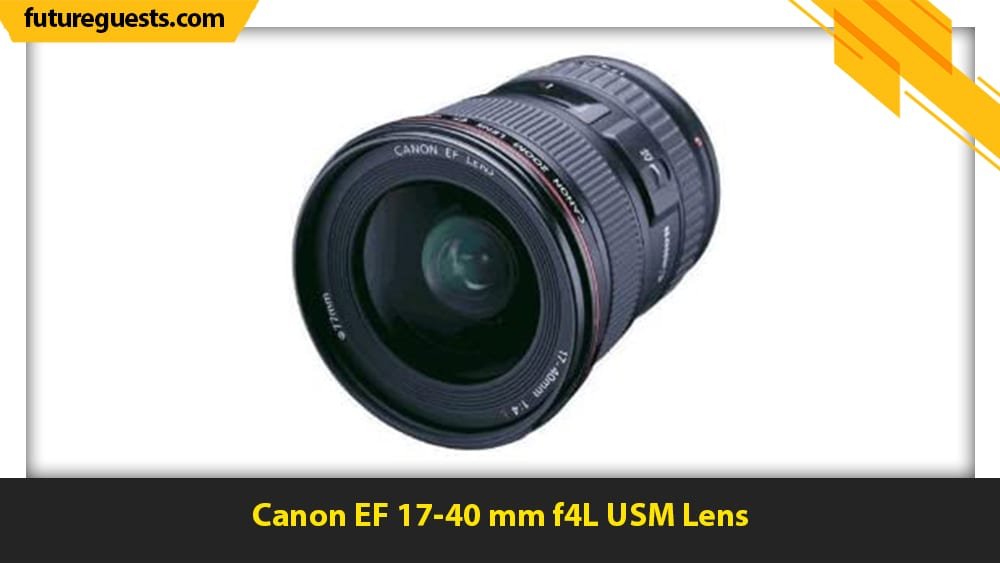
The Canon EF 17-40 mm f/4L USM lens is one of the best options for real estate photography.
This ultra wide-angle zoom lens is compatible with both full-frame Canon EF-mount DSLRs and APS-C models. With APS-C models, the equivalent focal length is 27.2-64 mm.
Weighing only 1.05 lbs, it is one of the lightest lenses available for real estate photography. The diameter and length of this lens are 84 mm and 97 mm, respectively.
This lens was first introduced to the market in 2003.
Pay attention that this lens has no image stabilization system. So, perhaps using it on a tripod is better for achieving a great image sharpness.
Features & Benefits
- One Super Ultra-Low Dispersion element together with three aspherical elements to minimize chromatic aberrations and spherical aberrations for better image sharpness.
- To reduce flare and ghosting, Super Spectra coating has been applied to the individual elements.
- The ring-type Ultrasonic Motor and internal focusing system makes fast and quiet autofocusing more practical.
- A full-time manual focus override is available for changing the position of focus based on your preferences.
- Consistent illumination throughout the zoom range can be achieved due to the f/4 maximum aperture.
- Sealed against dust and moisture to enable shooting in even bad weather conditions and increases the durability of the lens.
Pros
- Really fast and quiet autofocus performance
- Weather resistant
- Lightweight and portable
Cons
- No image stabilization system
- Some vertical aberrations in the image margins
- Lower performance near 17 mm focal length
Expert Opinion:
3. Canon EF 16-35 mm f/2.8L III USM Lens
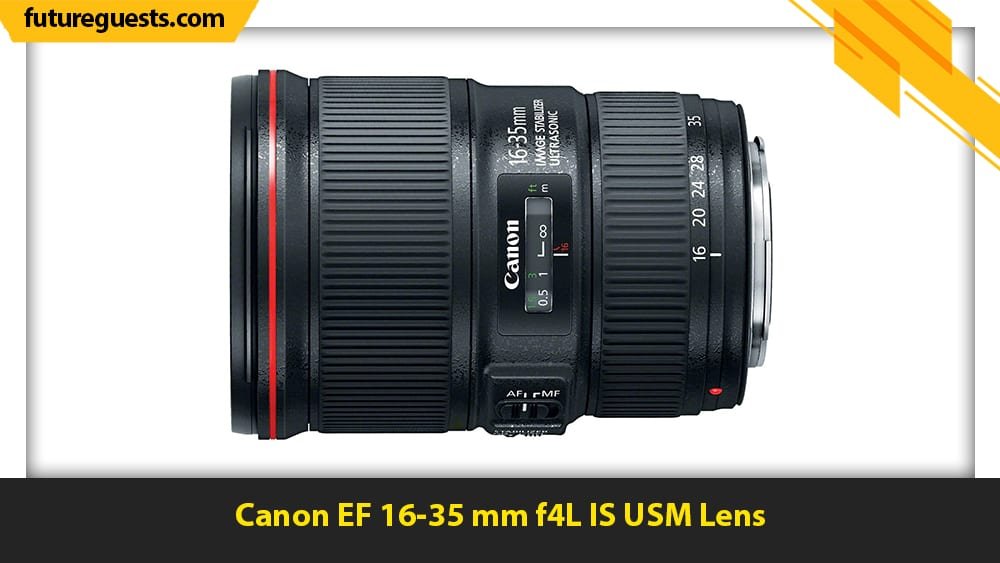
The Canon EF 16-35 mm f/2.8L III USM is one of the Canon’s best L-series lenses for real estate photography.
It is designed for full-frame Canon EF-mount DSLRs and works fine with APS-C models as well. With APS-C cameras the equivalent focal length is 25.6-56 mm.
It weights approximately 1.74 lbs and is therefore easily handholdable. The dimension and length of this lens are 88.5 mm and 127.5 mm, respectively.
This wide angle zoom lens was first introduced in 2016 and is therefore pretty up to date.
Pay attention that this lens has no image stabilization system so its better to mount it on a tripod if you can’t keep it still.
Features & Benefits
- Three aspherical elements and two Ultra-Low Dispersion glass elements are incorporated into the optical design of this lens to deliver ultra-sharp images with minimal chromatic aberrations.
- Subwavelength Coatings (SWC) and Air Sphere Coatings (ASC) are applied to individual elements to prevent reflections and minimize flare and ghosting.
- The f/2.8 maximum aperture gives great control over depth of field. This means that you can create photos with perfectly blurred background if needed. Also, this aperture is really beneficial for working in buildings with poor lighting conditions.
- Ring-type Ultrasonic Motor is accompanied with internal focusing design and full-time manual focus operation to enable fast, quiet and accurate focusing performance.
- Sealed against dust and moisture to enable shooting in even bad weather conditions and increases the durability of the lens.
- Fluorine coating has been applied to the front bulbous element to keep sticking of the residues at minimum.
Pros
- Ultra-sharp images with minimal chromatic aberrations
- Really fast and quiet autofocus performance
- Weather resistant
Cons
- No image stabilization system
- Heavy vignetting when wide open
Expert Opinion:
4. Canon EF 14 mm f/2.8L II USM Lens
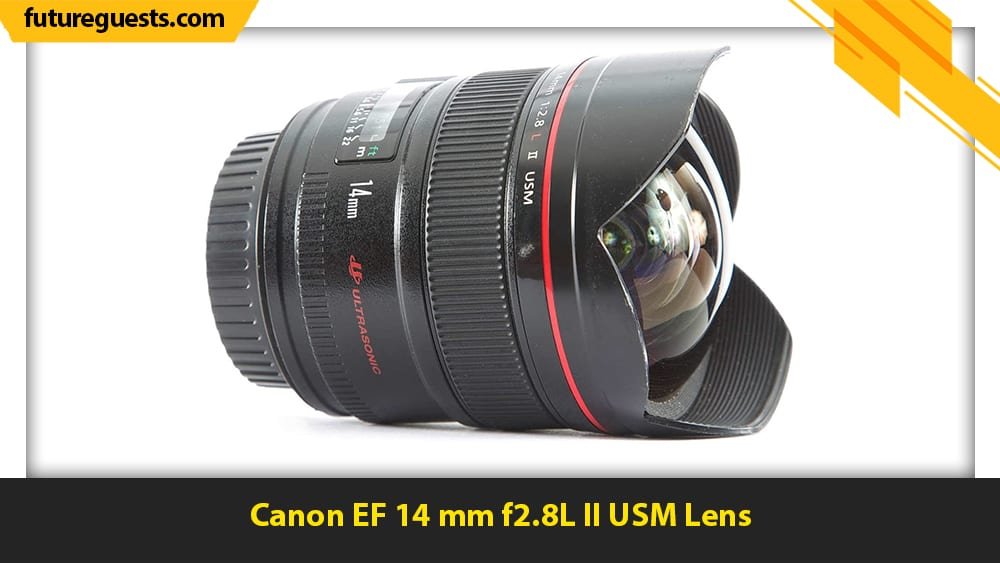
This is one of the best prime lenses for real estate photography due to its wide angle.
It is designed for full-frame Canon EF-mount DSLRs and works fine with APS-C models as well. The equivalent focal length with the APS-C camera models is 22.4 mm.
It weighs only 1.42 lbs and is pretty handholdable with the dimension of 80 x 94 mm. This lens became available in the market for the first time in 2007.
When shooting, do your best to hold your camera as still as you can because it has no image stabilization system.
Features & Benefits:
- Two aspherical elements and two Ultra-Low Dispersion elements are used inside the optical design of this lens to reduce chromatic and spherical aberrations.
Better sharpness, clarity and image quality is achieved by using these elements. - Flare and ghosting are reduced by applying Super Spectra coating to individual elements. This way, better contrast and color fidelity is achieved when working in the buildings with poor lighting conditions.
- The f/2.8 maximum aperture gives a lot of control over depth of field for creating blurred backgrounds. It is also very helpful for shooting in poor lighting conditions.
- The ring-type Ultrasonic Motor accompanied with internal focusing mechanism and manual focus override makes fast, quiet and accurate focusing possible.
- The Canon EF 14 mm f/2.8L II USM lens is sealed against dust and moisture for use in bad weather conditions.
Pros
- Really fast and quiet autofocus performance
- Great control over depth of field
- Weather resistant
Cons
- No image stabilization system
- May experience sharpness issues
Expert Opinion:
5. Canon EF-M 18-150mm f/3.5-6.3 IS STM Lens

The Canon EF-M 18-150mm f/3.5-6.3 IS STM is a multi-purpose lens with a very versatile focal length range.
It is designed for EF-M-mount mirrorless cameras. The equivalent focal length on APS-C format cameras is 28.8-240 mm.
Among different lenses available in the market, mirrorless lenses are the lightest. This lens weighs only 0.66 lbs. Therefore, you can handhold it for a really long periods of time without getting tired.
Also, mirrorless lenses are very compact. The diameter and length of this lens are only 60.9 mm and 86.5 mm, respectively.
This lens was introduced in 2016 for the first time.
Keep in mind that this lens is not sealed against dust and moisture so you should be really careful not to use it in bad weather conditions or provide it additional caps.
Features & Benefits
- The advanced optical design is able to maintain a compact, lightweight form factor together with enhanced sharpness and even illumination throughout the zoom range.
- The Stepper Motor (STM) technology used inside focusing system of this lens allows fast, smooth and near-silent autofocusing performance.
- Advanced image stabilizing system to reduce the appearance of shake up to four shutter speed stops. This enables getting extremely sharp images even when doing handheld shooting.
- The panning feature accompanied with the image stabilizing system reduces the effect of shake for even better results.
Pros
- Fast and quiet autofocus performance
- Covering an extended focal length range
- Advanced image stabilization technology
Cons
- Not sealed against dust and moisture
- May experience struggles in low light settings
Expert Opinion:
6. Canon EF-M 11-22 mm f/4-5.6 IS STM Lens
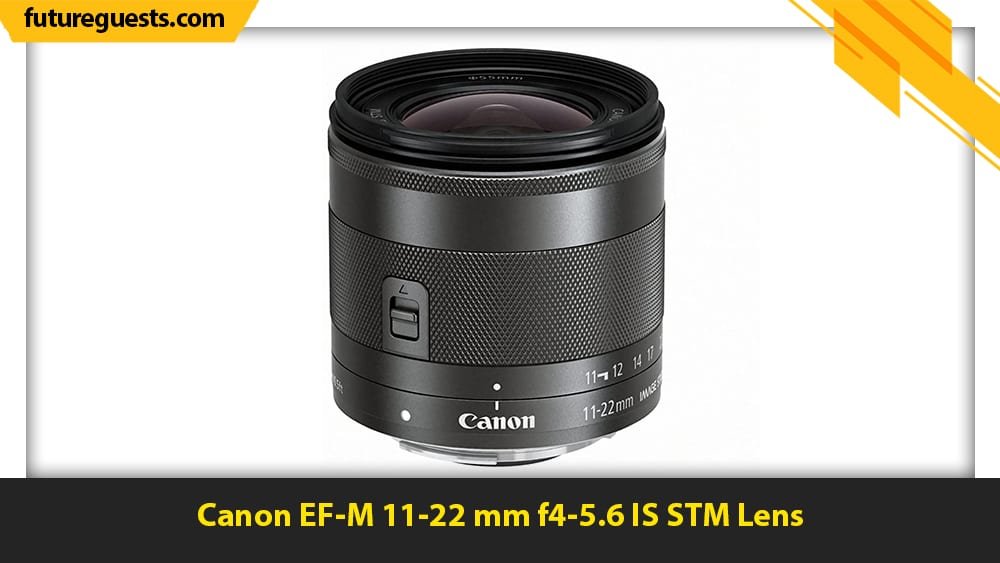
If you are looking for a very wide-angle lens for real estate photography, then you should go for Canon EF-M 11-22 mm f/4-5.6 IS STM lens.
This lens is designed for EF-M-mount mirrorless cameras. The equivalent focal length on APS-C format cameras is 18-35 mm.
Weighing only 0.48 lbs, this lens is very lightweight and handholdable for long periods of time.
The diameter and the length of the lens are 60.9 mm and 58.2 mm, respectively. Therefore, it is very compact and portable.
This lens was first introduced to the market in 2013.
Remember that this lens is not sealed against dust and moisture so take the essential precautions in harsh weather conditions.
Features & Benefits
- Two aspheric and one Ultra-Low Dispersion lens elements, which are incorporated into the optical design of this lens help achieve superb image quality and sharpness throughout the zoom range.
- The circular 7-blade aperture of this lens is able to produce beautiful, soft backgrounds.
- The Canon EF-M 11-22 mm f/4-5.6 IS STM lens takes advantage of both rear focus system and built-in Stepping Motor technology to perform fast and near-silent focusing performance.
Moreover, this lens has the manual focusing option. - The image stabilization system of this lens is able to reduce appearance of shake up to three shutter speed stops.
This feature combined with the light weight of this lens make it ideal for handhold shooting.
Pros
- Fast and quiet autofocus performance
- Excellent image stabilization technology
- Superb image quality and sharp images
- Really compact and portable
Cons
- Not sealed against dust and moisture
- May experience issues in poor lighting conditions
Expert Opinion:
7. Canon EF-M 32 mm f/1.4 STM Lens
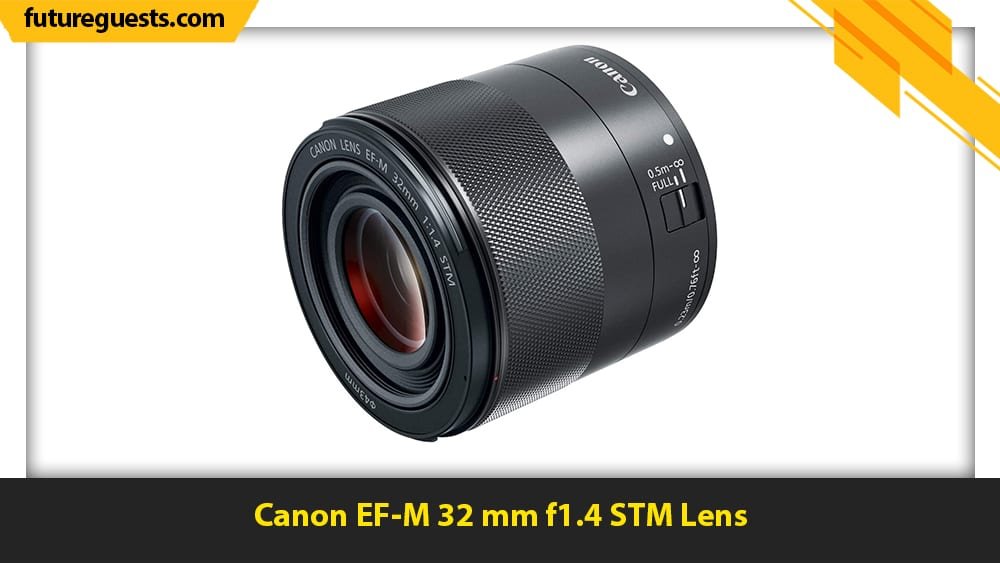
One of the most recently introduced lenses that is also ideal for real estate photography is the Canon EF-M 32 mm f/1.4 STM lens.
It is designed for the EF-M-mount mirrorless cameras. On APS-C format cameras, the equivalent focal length is 51.2 mm.
The lens weighs only 0.52 lbs and can be easily handheld for long periods of time.
The diameter and length of this lens are 60.9 mm and 56.5 mm, respectively. Therefore, it is very compact and portable.
This lens first came into the market in 2018. So, it has a very up to date design.
However, remember that it doesn’t have the dust and moisture sealings. Therefore, you need to provide it additional caps if you want to use it in bad weather conditions.
Furthermore, it doesn’t have the image stabilization system.
However, it has many beneficial features as follow…
Features & Benefits
- Spherical aberrations and distortions are reduced by use of a glass-molded aspherical lens element inside the lens optical design.
- Super Spectra Coatings have been applied to the individual elements for reducing flare and ghosting and preserving color accuracy.
- The maximum aperture of f/1.4 gives great control over depth of field. It can also control the amount of light input into the lens.
Therefore, it is really helpful for photographing in the buildings with poor lighting conditions. - The Stepping Motor technology used inside the Canon EF-M 32 mm f/1.4 STM lens allows fast and silent autofocusing performance.
- You can take advantage of the full-time manual focus override option to change the position of the focus based on your own preferences.
- Creating a bokeh quality is made possible by using a rounded seven-blade diaphragm.
Pros
- Very fast and quiet autofocus performance
- Great image quality and sharp images
- Really compact and portable
- Reasonable price
Cons
- Not sealed against dust and moisture
- No image stabilization system
Expert Opinion:
Best Nikon Lenses for Real Estate Photography in 2020
8. Nikon AF-S NIKKOR 16-35 mm f/4G ED VR Lens

The Nikon AF-S NIKKOR 16-35 mm f/4G ED VR lens is one of the perfect lenses for real estate photography because of its diverse features.
It is designed for FX-format DSLR cameras. It is also compatible with DX-format cameras. When used with DX-format sensors, the equivalent focal length is 24-52.5 mm.
It is very handholdable since it weighs only 1.5 lbs. The diameter and length of this lens are 82.5 mm and 125 mm, respectively.
This lens was first announced in February 2010.
Features & Benefits
- The f/4 maximum aperture provides the benefit of maintaining a constant illumination throughout the zoom range.
- Three aspherical and two Extra-Low Dispersion elements are used to minimize distortion and chromatic aberrations throughout the zoom range.
- Nano Crystal coating has been applied to individual elements to reduce flare and ghosting for higher image sharpness and clarity.
- The Silent Wave Motor technology used inside the autofocus system of this lens enables fast, accurate and near-silent autofocusing.
- The image stabilization system of this lens is able to reduce appearance of shake up to four shutter speed stops.
- The Nikon AF-S NIKKOR 16-35 mm f/4G ED VR lens is sealed against dust and moisture for better functioning in bad weather conditions.
Pros
- Fast and quiet autofocus performance
- Great image stabilization system
- High image quality due to reduced aberrations and distortions
- Dust- and water-resistant
Cons
- Some functioning issues near 16 mm focal length
- Distortions in 16 mm focal length
Expert Opinion:
9. Nikon AF-S DX NIKKOR 12-24 mm f/4G IF-ED Lens
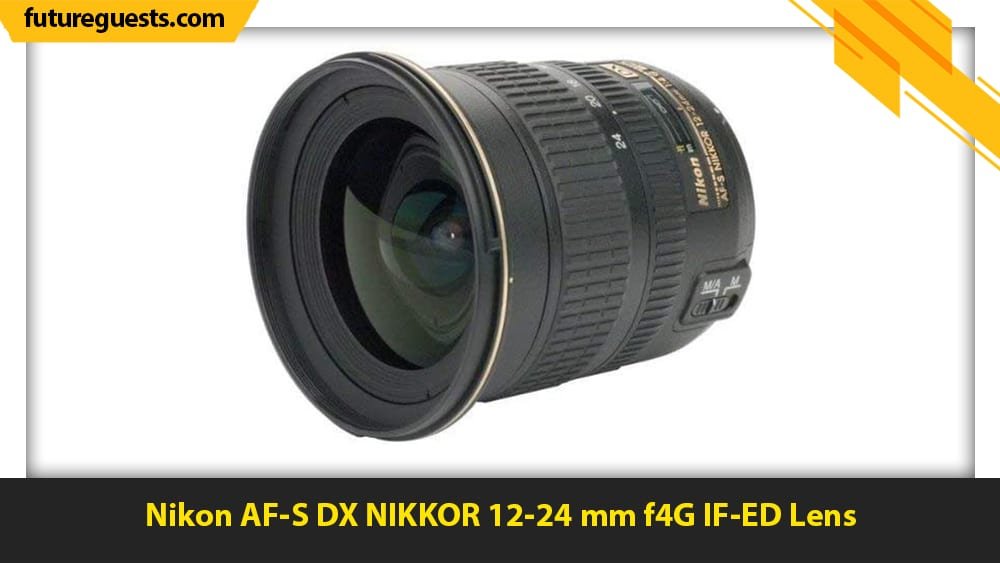
Another option for your Nikon camera and for the purpose of real estate photography is Nikon AF-S DX NIKKOR 12-24 mm f/4G IF-ED lens.
This lens is specially designed for DX-format DSLR cameras and is really compact. Its diameter and length are 82 mm and 90 mm, respectively.
It weighs only 1 lbs and it is therefore really easy to handhold this lens.
It was announced in February 2003 for the first time.
You must know that it does not have any image stabilization system.
Therefore, you should try to keep it very still while doing handhold shooting. You can also mount your camera on a tripod or monopod for the best results.
This lens is not sealed against dust and moisture so you shouldn’t take it out in rainy weather unless you use other types of protection.
Features & Benefits
- The f/4 maximum aperture is really helpful for working in buildings with poor lighting conditions and maintaining consistent illumination.
- Three aspherical and two Extra-Low Dispersion elements are used inside the optical design of this lens to decrease distortions, chromatic aberrations and color fringing and achieve higher image quality and color accuracy.
- Super Integrated coating has been applied to individual elements to reduce flare and ghosting.
- The Silent Wave Motor technology that has been used inside the autofocusing system of Nikon AF-S DX NIKKOR 12-24 mm f/4G IF-ED lens allows fast and near-silent focusing performance.
- The full-time manual override option is also available for changing the position of focus according to your own preferences.
Pros
- Fast and quiet autofocus performance
- High image quality due to reduced aberrations and distortions
- Really compact and portable
- Very light weight
- Very sturdy workmanship
Cons
- Image quality is not the best in low light
- Slight barrel distortion around 12 mm focal length
- No image stabilization system
- Not weather-resistant
10. Nikon AF-S FX NIKKOR 20 mm f/1.8G ED Lens
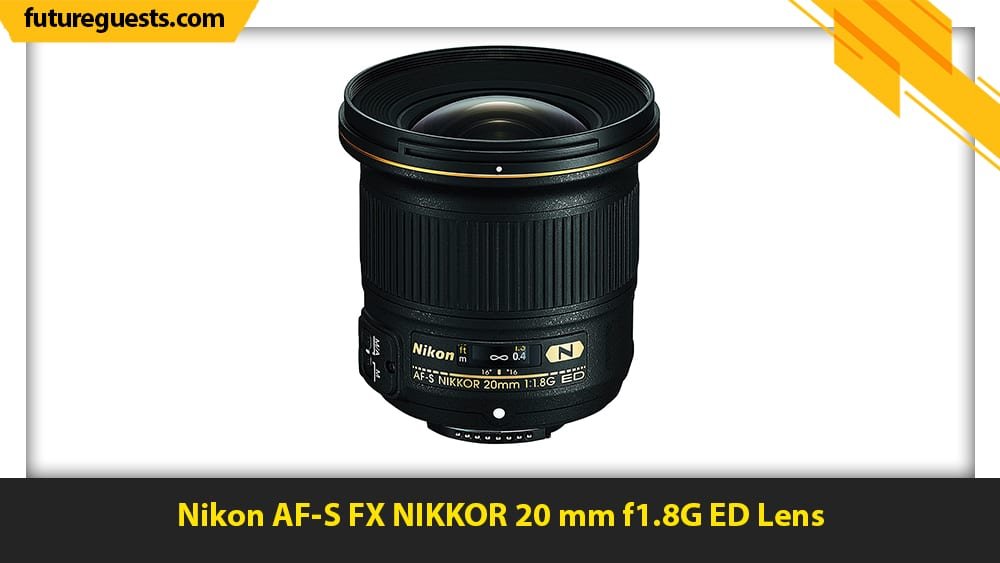
If you are looking for a nice prime lens for real estate photography, then you should go for the Nikon AF-S FX NIKKOR 20mm f/1.8G ED lens.
This lens is designed for the FX-format Nikon F-mount cameras. It can also be used with the DX-format cameras. In this case, the equivalent focal length will be 30 mm.
Considering that the diameter and length of this lens are only 82.5 mm and 80.5 mm, respectively, it is really compact and portable.
It weighs only 0.78 lbs and can be used for handhold shooting for long periods of time.
It became available in the market in 2014 for the first time.
This lens doesn’t have the image stabilization system so be sure to use it on top of a tripod or monopod to reduce appearance of shake.
Features & Benefits:
- The f/1.8 maximum aperture provides a lot of control over the depth of field. Beautifully blurred backgrounds can be produced using this feature. It is also really helpful for shooting in buildings with poor lighting conditions.
- Two aspherical and Two Extra-Low Dispersion glass elements are incorporated inside the optical design of this lens to reduce distortion and chromatic aberrations. This enables delivering photos with supreme image quality.
- Nano Crystal and Super Integrated coatings have been applied to individual elements to minimize flare and ghosting and enhance color accuracy.
- The Silent Wave Motor technology is used inside the autofocusing system, which enables fast, accurate and near-silent autofocusing performance.
- It features the manual override option, which can be used for a more selective control over the position of focus.
- It is dust and moisture sealed, so it can be used in bad weather conditions.
Pros
- Fast and quiet autofocus performance
- Really compact and portable
- Very light weight
- Sealed against dust and moisture
Cons
- No image stabilization system
- Some chromatic aberration issues
Expert Opinion:
11. Nikon AF-S NIKKOR 50 mm f/1.8G Lens
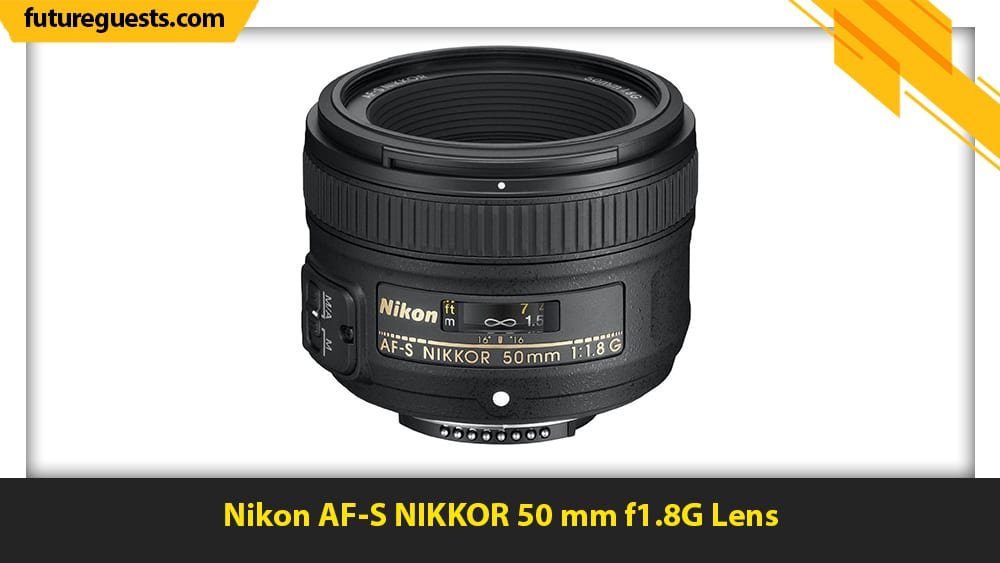
Another great budget prime lens for real estate photography is the Nikon AF-S NIKKOR 50 mm f/1.8G lens.
It is designed for FX-format Nikon F-mount cameras. However, it is also compatible with DX-format cameras and provides an equivalent 75 mm focal length.
This lens is really compact with a diameter and length of 52.5 mm and 72 mm, respectively.
It weighs only 0.41 lbs and can be easily handheld for long periods of time. This lens was first introduced to the market in 2011.
Note that it does not have any image stabilization system to reduce the effects of shake. So, it is better for this lens to be used together with a tripod or monopod.
Features & Benefits
- The f/1.8 maximum aperture provides extensive control over depth of field. It can be used to create a shallow depth of field. It is also very beneficial for shooting in buildings with poor lighting conditions.
- The optical design of this lens consists of one aspherical element to reduce distortions and chromatic aberrations for higher image quality.
- Super Integrated coating has been applied to individual elements to reduce flare and ghosting and enhance color accuracy and contrast.
- Silent Wave Motor technology has been incorporated into the autofocusing system of this lens to enable fast, accurate and near-silent autofocusing.
- The Nikon AF-S NIKKOR 50 mm f/1.8G lens features manual focus override option to easily control the position of focus.
- This lens is sealed against dust and moisture enabling shooting in harsh weather conditions.
Pros
- Extremely compact and portable
- Fast and quiet autofocus performance
- Very light weight
- Sealed against dust and moisture
- Very reasonable price
Cons
- No image stabilization system
- Some image sharpness issues
Expert Opinion:
12. Nikon 1 NIKKOR AW 11-27.5 mm f/3.5-5.6 Lens

One of the ideal options for real estate photography using mirrorless cameras would be the Nikon 1 NIKKOR AW 11-27.5 mm f/3.5-5.6 lens.
This lens is specifically designed for Nikon 1 AW mirrorless camera series. On 35 mm sensor formats, the equivalent focal length is 30-74 mm.
The lenses of mirrorless cameras are generally light and compact. The diameter and length of this lens are 63 mm and 56.5 mm, respectively.
It weighs only 0.4 lbs and can be used for handhold photo shooting for extended periods of time.
It was first announced in 2013.
This lens does not have the image stabilization system. However, it has many other interesting features as follows…
Features & Benefits
- Inside the optical design of this lens, one aspherical and one Extra-Low Dispersion lens elements have been used to reduce distortion and chromatic aberrations.
- The Stepper Motor technology used inside the autofocus system of this lens provides fast and accurate autofocusing performance.
- The 7-blade diaphragm of this lens is capable of producing beautiful, soft backgrounds.
- This lens is waterproof meaning that it can be used underwater to a depth of 15 m.
- The NIKKOR AW 11-27.5 mm f/3.5-5.6 lens can tolerate the low temperatures down to -10 Celsius degrees.
- This lens is shockproof from heights of up to 2 meters. This means that it would still function well if it accidentally drops from a height of 2 meters.
Pros
- Extremely compact and portable
- Waterproof, shockproof and freezeproof
- Very light weight
- Very reasonable price
Cons
- No image stabilization system
- Some image sharpness issues
13. Nikon 1 NIKKOR 18.5mm f/1.8 Lens

The Nikon 1 NIKKOR 18.5mm f/1.8 lens is one of the lenses that I would definitely recommend for doing real estate photography with mirrorless cameras.
It is exclusively designed for CX-format Nikon 1 mirrorless camera series. On 35 mm-format sensors, the equivalent focal length would be 50 mm.
The approximate diameter and length of this lens are 56 mm and 36 mm, respectively. Therefore, it is one of the most compact lenses available in the market.
It weighs only 0.15 lbs, which is extremely low compared to the other lenses.
It was announced for the first time in 2012.
This lens has no image stabilization system so it is better to use in on a tripod or monopod for the best image sharpness results.
Furthermore, it is not sealed against dust and moisture. Therefore, you should be really careful not to use it in harsh weather conditions.
Features & Benefits
- The f/1.8 maximum aperture provides a lot of control over depth of field and is useful for shooting in poor lighting conditions. A beautiful shallow depth of field can be produced using this feature.
- One aspherical glass element has been used to minimize distortion and chromatic aberrations, which enhances the image quality.
- It takes advantage of the rear focusing autofocus system and the motor type is Micromotor.
- The 7-blade diaphragm is useful for creating beautiful, soft backgrounds.
Pros
- Extremely compact and portable
- Great control over depth of field
- Very light weight
- Very reasonable price
Cons
- No image stabilization system
- Not sealed against dust and moisture
Expert Opinion:
14. Nikon 1 NIKKOR VR 10-30 mm f/3.5-5.6 PD-Zoom Lens
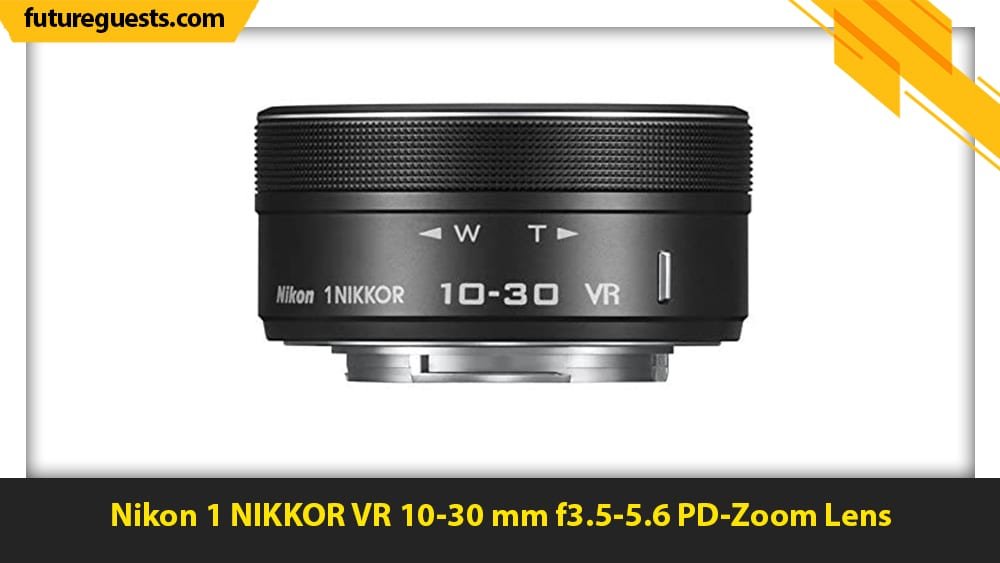
Another option for mirrorless cameras for the purpose of real estate photography is the Nikon 1 NIKKOR VR 10-30mm f/3.5-5.6 PD-Zoom lens.
This lens is exclusively designed for CX-format Nikon 1 mirrorless camera series. The equivalent focal length when used with 35 mm-format cameras would be 27-81 mm.
The diameter and length of this lens are 58 mm and 28 mm, respectively. It is therefore really compact and light weighing only 0.19 lbs.
It was introduced for the first time in 2014.
This lens is not sealed against dust and moisture so you need to be very careful to protect it in harsh weather conditions.
Features & Benefits
- One Extra-Low Dispersion and four aspherical glass elements have been incorporated to the optical design of this lens to reduce distortion and chromatic aberrations.
This increases image quality and sharpness. - The Stepper Motor technology used inside the focusing system of this lens allows fast and quiet autofocusing.
- The Nikon 1 NIKKOR VR 10-30mm f/3.5-5.6 PD-Zoom lens has a built-in image stabilization system, which is able to reduce the appearance of shake up to about three shutter speed stops.
- 7 rounded diaphragm blades are beneficial for creating beautiful, soft backgrounds.
Pros
- High image quality and clarity
- Extremely compact and portable
- Advanced image stabilization system
- Very reasonable price
- Very versatile focal length range
- Extremely light weight
Cons
- Not sealed against dust and moisture
- Not a durable and sturdy design
- No threads for putting on filters
Best Lenses for Real Estate Photography — Buyers Guide
Professional real estate photography needs its own specific lenses like any other type of photography.
So, what type of specifications should a good lens possess to be suitable for real estate photography?
What follows provides a comprehensive guide to help you find ideal lenses for your camera according to your budget and specific needs.
It also explains any terms and expressions that might be unfamiliar to you.
Now without further ado, let’s dive right in.
1. Best focal length for real estate photography
Focal length is measured in millimeters and it is defined as the distance between the lens and the image sensor. In zoom lenses, both minimum and maximum focal lengths are written on the lens.
A maximum of 10-50 mm lens covers just enough room space to allow shooting perfect photos in real estate photography.
Such lenses are regarded as wide-angle. A wide-angle lens is a lens with a short focal length that can capture a wide field of view.
These lenses could capture more of the scene compared to normal lenses. Therefore, they give the viewer the feeling of being in the scene.
2. Prime or Zoom Lens for real estate photography?
Prime lenses have fixed focal lengths, which means that if you want to make an object appear larger, you have to get physically closer to that.
A zoom lens, on the other hand, has variable focal length range, so you can make the objects appear larger or smaller using the zoom ring.
A zoom lens costs more than a prime lens with the same quality.
Therefore, deciding between a zoom lens and prime lens for real estate photography is totally a financial matter.
However, I personally prefer prime lenses as they have fewer moving parts and therefore they have higher image quality, better functioning and lower weight.
3. Chromatic Aberration
Chromatic aberration is referred to the situation when a lens isn’t able to bring all wavelengths of color to the same focal plane. This is caused by lens dispersion.
This Phenomenon could result in blurred or noticeable colored edges inside the image.
So, if you want to shoot perfect photos in real estate photography, you should pay attention to choose a lens with minimal chromatic aberration.
The more glass elements a lens has, the less chromatic aberration it experiences.
However, this is not a general rule. Therefore, the reviews and comments of other people can be really beneficial in this regard.
4. Autofocus or Manual Focus Option?
Manual focusing is when you have to manually adjust the focus ring until the image is sharp enough.
In auto focusing however, the camera itself determines the sharpest shooting mode.
So, if you are a professional already, I recommend using the manual focus lenses as you will have a better chance of finding the sharpest shooting mode using the viewfinder instead of the LCD screen.
Moreover, if you want to shoot outdoors in the sunlight, holding the viewfinder against your eye will eliminate glare on the LCD screen while trying to find the best sharpness of focus.
There are also lenses that have autofocus with a manual focus override option, which provide the benefits of both manual and autofocus lenses.
For real estate photography, I recommend these types of lenses as they have quicker focusing function.
Canon mostly uses the Ultrasonic Motor technology for its high-tech lenses, while Nikon generally uses Silent Wave Motor technology for its high-quality lenses.
5. Lens Maximum Aperture for real estate photography?
One of the most important features of a lens would be its maximum aperture.
Maximum aperture is the amount of light that the lens allows to pass its opening. Therefore, this is the feature that determines how dark or bright your images are going to be.
This feature is stated in f/stops and usually appears on the body of the lens.
The lower the aperture, the more light it allows to pass through its opening.
This is really beneficial for shooting in buildings with poor lighting conditions.
For real estate photography, this feature is really important because sometimes you don`t have enough light while shooting interior of the buildings.
I would recommend getting a lens with a lower maximum aperture for real estate photography.
6. Full-Frame or APS-C Lens?
Lenses designed for full-frame cameras have a 35 mm film frame. However, APS-C format frames measure 16.7 x 30.2 mm.
So obviously, the APS-C lenses have smaller frames. When APS-C lenses are used on full-frame cameras, you get a crop factor.
This means that to fill the frame, the image will be magnified.
You can also mount a full-frame lens on an APS-C format camera. In this case, you may get black circles around your images.
You can choose between either the full-frame or APS-C lenses for real estate photography.
However, I recommend to use your APS-C lenses with APS-C format cameras and full-frame lenses with full-frame cameras.
Nikon uses the term FX-format for its full-frame lenses and cameras and the term DX-format for its APS-C ones.
7. Image Stabilization System
The image stabilization system of a lens is able to reduce the appearance of shake and enhance image sharpness and clarity.
This feature is very beneficial for handhold shooting.
For other types of photography such as sports or wildlife photography, this feature is absolutely crucial.
For real estate photography however, this feature is beneficial but not obligatory.
If your budget is not an issue, I recommend getting a lens with image stabilization system.
8. Weather Resistance
It is important for a lens to be weather-resistant if you want to shoot outdoors.
Being weather-resistant means having rubber materials in special places of the lens, which seal it against dust and moisture.
Remember that being water-resistant is different from being water-proof.
You cannot dip a water-resistant lens in the water. However, you can shoot photos underwater using the waterproof lenses.
For real estate photography, I recommend getting a weather-resistant lens because you definitely need to shoot photos of the buildings exteriors as well.
Having a weather-resistant lens is really beneficial in such conditions and for places that have a lot of rainfall.
9. Lenses for Mirrorless Cameras
Mirrorless cameras are different from DSLR cameras because they don’t have the reflex mirror and optical viewfinder. They have a digital display system instead.
These cameras have become popular just recently. They were introduced in 2004 and because of their compactness and low weight, they have attracted a lot of attention.
For mirrorless cameras, you need to choose a lens that is exclusively designed for them.
You can also choose from the lenses of DSLR cameras and attach it to your mirrorless camera using an adaptor.
For real estate photography, if you cannot find your desired lens, you can adopt the latter case.
Best Lenses for Real Estate Photography — Conclusions
In this article, I have reviewed 14 best Canon and Nikon lenses for real estate photography!
A buyers guide was also provided to explain any unknown lens terminology and guide you on what aspects to look for in a lens before buying.
As I explained, you need to pay attention to many factors and parameters when choosing your ideal lens for real estate photography.
The three most important parameters to consider are focal length, chromatic aberration and maximum aperture.
The focal length needs to be in the range of 10-50 mm.
In general, the lesser the chromatic aberration, the better.
Finally, lower values of the maximum aperture are preferred because they allow more control over the depth of field.
You can choose a good lens to buy based on these characteristics and your own specific needs.
Here are my suggestions:
- Among the 14 lenses I’ve reviewed above for real estate photography, I recommend Canon EF 14 mm f/2.8L II USM for Canon cameras
and Nikon AF-S FX NIKKOR 20 mm f/1.8G ED lens for Nikon cameras if the you do not have any financial restrictions.These lenses are wide-angle, with great image quality and lower maximum apertures.
- If you are looking for a cheaper lens, I recommend Canon EF 17-40 mm f/4L USM lens for Canon cameras
and Nikon AF-S NIKKOR 50 mm f/1.8G lens for Nikon cameras.These lenses cover a versatile focal range and deliver good image quality.
- If you own a mirrorless camera, I suggest Canon EF-M 32 mm f/1.4 STM lens for Canon
and Nikon 1 NIKKOR 18.5mm f/1.8 lens for Nikon cameras.Great image quality, low maximum aperture and compactness are the main features of these lenses.







